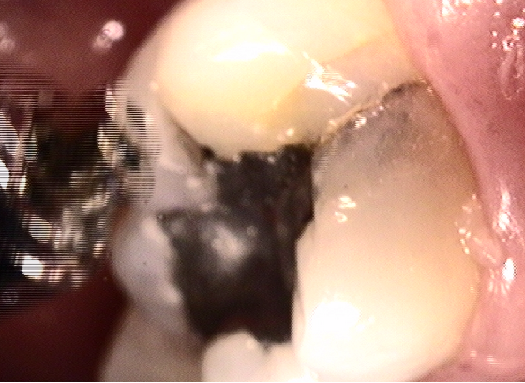- Dental pain - dental pain is most commonly caused by two things:
- infection - This is most commonly described to me by patients as an abscess. Oftentimes patients may think they have this condition, but, in fact, do not. Pain that is short-lived (under 30 seconds) caused by hot, cold, or sweets can usually be fixed by removing the decay (infection) present and placing a restoration (filling). Pain that lasts longer than 30 seconds or is spontaneous may indicate that the pulp (nerve) of the tooth has been encroached upon. This type of dental pain requires endodontic (root canal) therapy. An abscess is usually caused by untreated decay, "cavities." Abscesses can range from no swelling to massive swelling. Abscesses mostly only cause pain when biting due to the pressure build up at the bottom of the root. Abscessed teeth are not usually sensitive to hot and cold because the nerve of the tooth itself is long since dead and the pain is actually being felt by the bone socket the tooth is sitting in.
- sinus infections may cause upper back teeth to hurt as a constant ache or pain when biting
- fracture - Tooth pain can also be caused if there is a fracture present. This dental pain is experienced when biting. The tooth will flex when a biting force is placed upon it, thus opening the fracture slightly allowing the nerve to be exposed. Dental fractures can also cause a tooth pain to hot and cold that is quick to go away. Fractures are often seen on back teeth or teeth with large fillings in them, especially amalgam or metal fillings.
2. Gum pain
- Gum pain can often present as tooth pain. There are acute gum infections that are painful, however they have a distinct appearance. Sometimes gums can look fine on the surface yet patients experience an acute dental type pain that isn't caused by a tooth. These gums can be very inflamed and bleed easily. This is often seen in patients that haven't had their dental cleanings and check-ups in an extended time or patients that have had something lodged between their teeth such as a popcorn husk. This type of pain usually has symptoms of hot and cold dental pain or pain upon biting.
- There have been books written on this subject, so I won’t
go into too much detail. Most jaw pain is from muscle aches from overuse.
The test for this is to massage over the muscles at the corner of the jaw,
the temples, and above the ears. If these are painful, then it is a muscle
issue. Treatment for this is having the patient relax when he or she
notices he or she is clenching or grinding and wearing an occlusal or bite
guard at night time. Jaw joint issues generally have a history of trauma,
clicking, jaw getting locked open, arthritis, among several other issues.
It is more common in women to have joint issues. Oral appliances are the
most widely used therapies for joint issues.
- There have been books written on this subject, so I won’t
go into too much detail. Most jaw pain is from muscle aches from overuse.
The test for this is to massage over the muscles at the corner of the jaw,
the temples, and above the ears. If these are painful, then it is a muscle
issue. Treatment for this is having the patient relax when he or she
notices he or she is clenching or grinding and wearing an occlusal or bite
guard at night time. Jaw joint issues generally have a history of trauma,
clicking, jaw getting locked open, arthritis, among several other issues.
It is more common in women to have joint issues. Oral appliances are the
most widely used therapies for joint issues.

